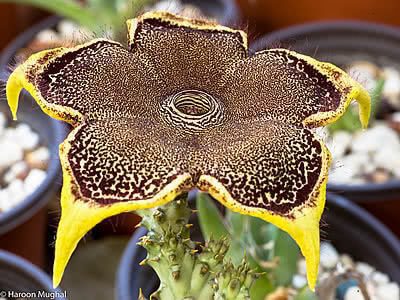The Persian Carpet Flower is a succulent plant native to the Great Lakes region of Africa (including Kenya, Tanzania, and Uganda), the Horn of Africa (Ethiopia, Somalia, Djibouti), and Yemen, including the Socotra archipelago. It thrives in arid terrain, at elevations ranging from 200 to 1500 meters above sea level. The genus Edithcolea is monotypic, meaning it consists of a single species: Edithcolea grandis.
The genus name, Edithcolea, is a tribute to Edith Cole (1859–1940), an explorer who collected the plant along with Lort Phillips during a botanical expedition in 1895 in northern Somalia. Until recently, this species was classified in the Asclepiadaceae family, which has now become the Asclepiadoideae subfamily within the Apocynaceae family.
In its habitat, the Persian Carpet Flower can be found in full sun, but it is more commonly located in semi-shaded areas among rocks or small bushes in dry and arid regions. It has a branched stem with decumbent branches, leafless and succulent, growing to about 30 centimeters in length. The stems are green with brown or red spots, armed with toothed edges resembling sharp thorns.

Its bisexual terminal flowers have a beautiful star-like shape, disproportionately large compared to the plant’s size, reaching up to 13 cm in diameter. The pale yellow flower features an intricate brown to reddish pattern, with hairs on the edges and emits a putrid carrion scent to attract its pollinators: flies. The fruit contains numerous seeds.
The Persian Carpet Flower should be cultivated in partial shade or filtered light, using well-draining sandy succulent substrate. It does not tolerate cold temperatures below 15ºC or excessive humidity, as this can lead to root and stem rot. Cultivate in a controlled environment with bright, indirect light, consistent warmth, and deep, spaced-out watering. Allow the substrate to completely dry between waterings. Plant in raised beds or pots with good drainage holes. Reduce watering in winter. Repot every two years to refresh the substrate and improve root aeration. It easily propagates through stem cuttings rooted in warmth, as well as by seeds in spring.


